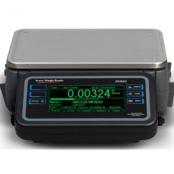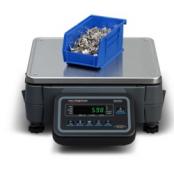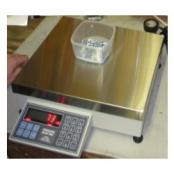Use up and down arrows to select available result. Press enter to go to selected search result. Touch devices users can use touch and swipe gestures.
We sell, repair, calibrate & rent scales

Digital Counting Scales look at the weight of the items you place on the weighing platform and divide the weight by the number of pieces you entered, to compute the average piece weight (APW). This is how a digital counting scale displays the number of pieces or parts or better yet how it works. The item(s) you are counting must be uniform in weight. No counting scale will ever work if there is a significant variation in the weight of the items. The larger the initial sample (100 pieces versus 5 pieces) the better results the counting scale can provide since it averages out any variations in the piece weights for accuracy.
When you're shopping for an inventory counting scale, be sure to think about the features and important options that you need such as making sure the scale has a counting function, rechargeable battery power for portability, numeric keypad, rs 232 serial or usb interfaces, audible alarm, removable stainless steel platform, legal for trade, programmable, aka ability to print bar codes or qr codes, etc...
Now once you find a couple of scales that you like, then you can determine which features are needs versus wants. When it comes to accurate weighing, you need precision counting scales that are an excellent value and allow you to accomplish industrial counting tasks very easily and quickly check total parts in the inventory. Whether you're employed by production facilities or a magazine printer, weighing tasks need to be easy to understand, including sample entry.
When you're doing part counting of large quantities, often you need to be able to keep track of various numbers such as the unit weight, tare weight, piece count, and total weight. This is where buying a scale with three displays is usually recommended. Also, depending on the weighing tasks, you typically need a scale with tare feature and a large platform size for check counting.
Many people buy a parts counting scale with more maximum capacity than they typically will be needing. The reason: "I want to be able weigh my two or three larger items that I have to count."
If 75% of the time you will be counting no more than 10 lbs of parts at a time, a 10 lb. capacity counting scale is the ideal choice as opposed to a 50 lb. capacity scale since you may be sacrificing resolution so you can have a larger capacity. Too many times, consumers see the large capacity and think they may need that in the future or they need it to count the couple of larger items that they have.
If you think you may need to weigh and count larger items in the future, just make sure you buy a counting scale with a remote scale option available. Examples include the Pennsylvania 7600, Avery Weigh-Tronix ZK-830, and Rice Lake Counterpart. Then when the time comes you can add a bench scale platform or even a 4’x4’ floor scale to your counting scales. That way you can weigh and count large and small amounts. You can also look for scales that have the accumulation function.
Contact us and we can give you some reviews on what products we believe would work the best for your application and who are the best counting scale manufacturers.
First, find a model that meets your capacity and accuracy requirements (remember the least amount of capacity you can handle is better). In fact, if you're going to be weighing really light pieces, then possibly a balance with parts counting or ZK830 counting scale with glass draftshield would be your best choice.
Then, look at the features required for your applications (both now and in the future) such as computer or barcode label printer interfacing capability, battery operation, ability to connect a larger platform scale (remote scale), extra storage memory, etc...
When comparing parts counting scales it is important to remember that readability means displayed resolution and displayed resolution is really just the ratio of capacity to readability. Displayed resolution is a good criteria to use when evaluating scales in addition to other sources such as weighing errors, ease of use, and other factors.
When looking at counting scales, internal resolution will be helpful in choosing the capacity that is best suited to your application as it can be an indicator of the lightest part that can be accurately counted. One thing is clear, when attempting to count certain light parts, counting scales with higher internal resolution will deliver higher counting accuracy for a given sample size.
Scale manufacturers use the term resolution to help describe the overall performance of the products that they make. They sometimes use it with the term "readability". Think of readability or graduations as a minimum readable weight change, one graduation or increment. However, readability or resolution by itself is not enough when deciding what scale you need.
For example, a scale that has a capacity of 50 lb and is readable to 0.001 lb is considered a much better performing scale than a scale that has a capacity of only 5 lb and a readability of 0.001 lb.
Although the smallest weight increment, readability, graduation etc... is the same for both scales. The 50 lb capacity scale has total divisions/graduations of 50,000 (50 / .001 = 50K). While the 5 lb scale has only 5000 divisions (5 / .001 = 5K). It takes a more accurate scale to provide 0.001 lb readability when weighing loads up to 50 pounds than one that is limited to 5 pounds.
Low Cost or economy counting scales generally don't have a 2nd scale option available. Ideally, you want to buy a counting scale that at least has a remote scale or (2nd scale) option available. This way you can eventually have the choice of adding a larger platform or floor scale to your counting scale to weigh and count larger amounts of parts or materials. An example would be the CCS-574 Dual Platform unit. Once you get your counting scale, there are a couple of things below to think about in order to maximize the accuracy and the effectiveness of the purchase.



Many parts counting procedures can be done with little or no errors. However, once you get into counting large numbers of parts, inconsistent parts, or counting with no standardized procedure, etc... there can be some errors. There are a couple of reasons listed below for counting scale errors.
Operator Error
Some operator errors are obvious such as forgetting to press "tare" for a container or miscounting the sample. Other errors are the result of the operator allowing the scale to be unlevel, allowing draft or fan to blow on the scale platter, allowing an item to touch the weigh platter and throw the weights off, or simply having a "bad attitude" and doing whatever they can quickly to finish the counts and go home.
While errors like these can always occur, hopefully a little basic training can inform and educate the operators how to use the scale. A nice feature many of the top counting scale manufacturers offer is a counting scale with operator prompts. These prompt the counting scale user what to do next, so he/she gets into a rhythm and consistently counts the way the process is supposed to work.
Another idea is to develop a standardized procedure when it comes to counting. The last thing you want to do is have one employee who uses a sample of 5 to count and another who uses a sample of 50. Normally the user manual will have some good suggestions too.
Sample Size Or Piece Weight Error
Believe it or not, even the exact same items can be slightly different weights. Many people think that because the pieces they are counting look the same and perform the same and have the same part number that they weigh the same. That is not always the case. This is why you need to take a wide sample in order to get an accurate representation of the parts you are counting.
Several manufacturers have mentioned in the past that a good rule of thumb when it comes to sampling is to use a minimum of 10 pieces but ideally a sample between 25 and 50 will yield the best counts.
One way to police sample sizes is to buy a counting scale that can be programmed to force the user to count a certain minimum sample size. So if the scale is programmed to require 30 pieces and the operator only samples 10, the scale will force the operator to add 20 additional pieces. This feature is found on several mid range parts counting scales. For a complete listing of our counting scales, please click the link below.
The smallest item a scale can count is dependent on the minimum piece weight. Calculating the minimum piece weight can be done in different ways and can be quite complicated...
But, a very simple and effective way to estimate this is to multiply the manufacturer’s recommended readability by five. This will give you a close estimate of the average piece weight the scale should weigh within.
As an example, to estimate the average minimum piece weight of a typical 60 pound capacity counting scale with an analog cell, displayed resolution of 30,000 divisions and stable readability of 60,000 divisions (0.001 lb.), you would use the following: 0.001 x 5 = 0.005 lb. Now compare that to a 70 pound capacity ZK830 scale from Avery Weigh-Tronix with displayed resolution of 100,000 divisions and stable readability of 3,500,000 divisions (0.00002 lb.), the estimated average minimum piece weight is 0.00002 x 5 = 0.0001 lb. This is the smallest recommended item each of these scales can count within the accuracy bounds selected.
While calculating the average minimum piece weight is useful to customers, on highly accurate counting scales with high internal resolution such as the ZK840, the piece weight can be calculated using the minimum sample size that will always guarantee the accuracy the customer has set within the scale.
On the ZK Counting Scales, the minimum sample weight can be easily calculated by using 0.01% of the scale’s full base capacity for dribble counting or 0.02% of the scale’s full base capacity for bulk sampling. This means that a on a 70 lb. scale, the scale can accurately calculate a pieces weigh with 99.75% accuracy by using a minimum sample weight over 0.007 lb. This minimum sample weight could come from a sample size of 5, 10, 50 or more pieces.

